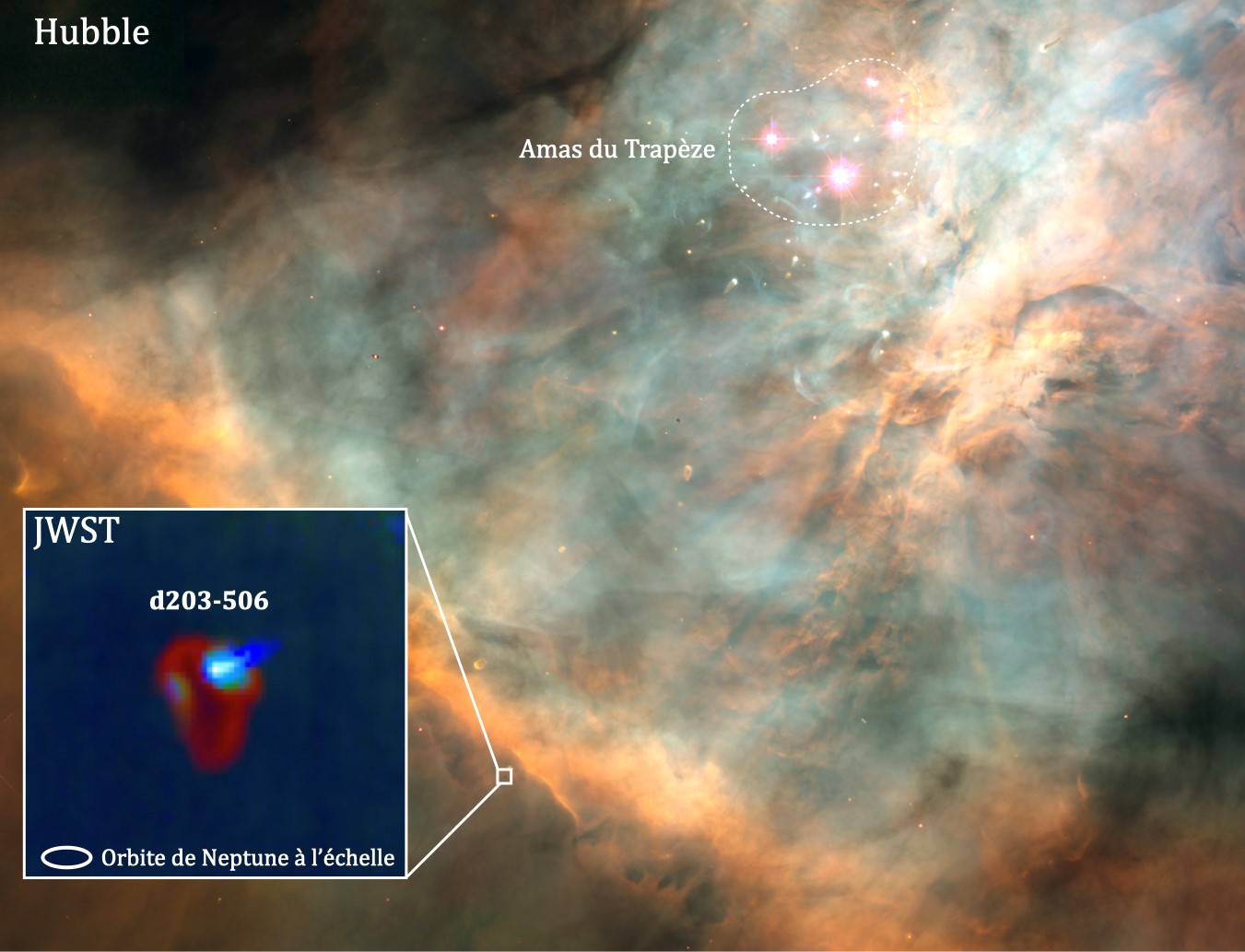James Webb Space Telescope Discovery
Clicking on each image will open the full resolution one. Try it!Clicking on "Raw images" image will yield all the relevant raw images.
Radiation from massive stars shapes planetary systems
How do planetary systems such as the Solar System form? To find out, CNRS scientists taking part in an international research team1 studied a stellar nursery, the Orion Nebula, using the James Webb Space Telescope2 . By observing a protoplanetary disc named d203-506, they have discovered the key role played by massive stars in the formation of such nascent planetary systems3 .
These stars, which are around 10 times more massive, and more importantly 100,000 times more luminous than the Sun, expose any planets forming in such systems nearby to very intense ultraviolet radiation. Depending on the mass of the star at the centre of the planetary system, this radiation can either help planets to form, or alternatively prevent them from doing so by dispersing their matter. In the Orion Nebula, the scientists found that, due to the intense irradiation from massive stars, a Jupiter-like planet would not be able to form in the planetary system d203-506.
This paper, which will make the front page of the journal Science on 1st March, 2024, shows with unprecedented precision the decisive role played by massive stars in shaping planetary systems, and opens up new perspectives on how such systems form.
Bibliography
A far-ultraviolet-driven photoevaporation flow observed in a protoplanetary disk. Olivier Berné, Emilie Habart, Els Peeters, Ilane Schroetter, Amelie Canin, Ameek Sidhu, Ryan Chown, Emeric Bron, Thomas J. Haworth, Pamela Klaassen, Boris Trahin, Dries Van De Putte, Felipe Alarcon, Marion Zannese, Alain Abergel, Edwin A. Bergin, Jeronimo Bernard-Salas, Christiaan Boersma, Jan Cami, Sara Cuadrado, Emmanuel Dartois, Daniel Dicken, Meriem El-Yajouri, Asuncion Fuente, Javier R. Goicoechea, Karl D. Gordon, Lina Issa, Christine Joblin, Olga Kannavou, Baria Khan, Ozan Lacinbala, David Languignon, Romane Le Gal, Alexandros Maragkoudakis, Raphael Meshaka, Yoko Okada, Takashi Onaka, Sofia Pasquini, Marc W. Pound, Massimo Robberto, Markus Rollig, Bethany Schefter, Thiebaut Schirmer, Thomas Simmer, Benoit Tabone, Alexander G. G. M. Tielens, S´ilvia Vicente, Mark G. Wolfire and PDRs4All team. Science, March 01, 2024.
Credit: CNRS
 Hubble image of the Orion Nebula, and a zoom in on the protoplanetary disc d203-506 taken with the James Webb Space Telescope (JWST).
© NASA/STScI/Rice Univ./C.O’Dell et al / O. Berné, I. Schrotter, PDRs4All
Hubble image of the Orion Nebula, and a zoom in on the protoplanetary disc d203-506 taken with the James Webb Space Telescope (JWST).
© NASA/STScI/Rice Univ./C.O’Dell et al / O. Berné, I. Schrotter, PDRs4All
 Orion-related JWST discoveries
Orion-related JWST discoveries
 More PDRs4all - JWST data
More PDRs4all - JWST data
 Science article (paid)
Science article (paid)